|
|
|
 |
|
"BUT AS FOR ME, I AM
LIKE
A GREEN OLIVE TREE IN THE HOUSE OF GOD"
PSALM 52
|
|

|
 |
If you
have a free morning to explore Jerusalem, try this
walking tour starting at the Olive Tree Hotel, north
of the Old City. It takes you through both the
bustling hustling city marketplace and quiet holy
areas for moments of reflection.
|
Recommended gear:
• Comfortable walking shoes
• Hat
• Bottle of water
• “Modest” attire for men and women (shoulders &
knees covered)
• Sense of humor
• Sense of adventure |
| |
Time
frame: Walked briskly, this walk could be completed
in 45 minutes. But allow a couple of hours to
explore and savor the sites along the way.
|
| A good
starting point is the
Olive Tree
Hotel, located on 23 St. George Street, adjacent
to Route 1, in the American Colony neighborhood
north of the Old City. |
| |
| Kitty
corner, diagonally across the street and to the
right, with one’s back to the entrance of The Olive
Tree Hotel, is Nablus Road. In the springtime, use
the tall purple-flowered jacaranda tree next to the
tower of the St George Cathedral as a landmark for Nablus Road.
On Nablus Road, go left and then take
an immediate right. |
| |
|
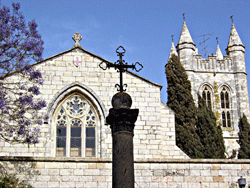 |
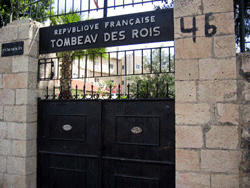 |
|
Photo: Gila
Yudkin |
Photo: Gila
Yudkin |
|
St. George Cathedral |
Entrance to the Tomb of the Kings |
| |
This
will bring you to Saladin Street. On your right,
you’ll see an orange sign saying “Tomb of the
Kings.” It will be pointing to a black grilled gate
with a sign “Tombeau des Rois.” (It’s French
property.) The gates will be locked. But not to
worry. There’s a small turquoise door to the left,
which is often open during the morning hours. Walk
right in, smile or wave, and turn right. Walk
parallel to the black gate on your right.
Soon you’ll find yourself descending a
two-thousand-year-old rock-cut staircase, past open
cisterns, to enter a huge courtyard. When you turn
left, you’ll see a magnificent frieze decorating the
tomb complex containing the first century AD tomb of
Queen Helena of Adiabene (today Kurdistan). According to the historian Josephus Flavius, the
bones of Queen Helena, a convert to Judaism, were
sent for burial in Jerusalem. Don’t miss the
original rolling stone still “in situ” (in place).
It once blocked the entrance to the complex of
burial chambers, typical of first century AD tombs. |
| |
Exit the
same way you entered. Return to Nablus Road
and turn left. You’ll pass the entrance to
St. George Cathedral
on your left and then the
Palestinian Pottery shop/residence, also
on your left. Across the street you will see
the US Consulate. DON’T LOSE YOUR PASSPORT!!!
The
American Consulate used to be right here.
But unfortunately they moved to a more distant
neighborhood.
On the side of the former American Consulate, to your
right, you face a large memorial plaque in memory of
Israeli soldiers who fell during the Six Day War.
Even further to the right, in an enclosed area, on
the ground level, are large stones which are part of
the “Third Wall”
which fortified Jerusalem in the first century AD.
The building of the Third Wall was initiated by
Herod Agrippas, grandson of Herod the Great, and
completed on the eve of the Judean revolt against
the Romans in 66 AD. The Third Wall defending
Jerusalem from the north, did not, however, prevent
the Romans from conquering the city. |
| |
|
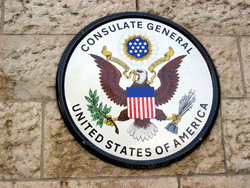 |
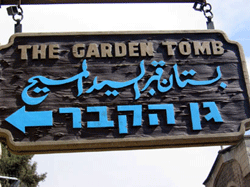 |
|
Photo: Gila
Yudkin |
Photo: Gila
Yudkin |
|
Former American Consulate |
Look for this sign |
| |
Continue along Nablus Road with a stone wall on your
left. When you come to a sign pointing
left to a narrow lane (Conrad Schick Street), turn
in: this is the entrance to the Garden Tomb.
The Garden Tomb,
discovered in 1867, is possibly the place where
Jesus was buried, in the tomb belonging to Joseph of
Arimathea. (See John 19:41) You will
also view Gordon’s Calvary,
identified in 1884 by Charles “Chinese” Gordon as
the “place of the skull,” Golgotha, where Jesus was
crucified.
If you are part of an organized tour, your itinerary
will include a visit to the Garden Tomb with
a tour and group fellowship. If you come on
your own to the Garden Tomb, you’ll find the
uplifting atmosphere conducive to individual prayer
and reflection. Plan to spend a few quiet
moments with your Bible and journal. (Ask the
concierge at your hotel to check opening hours for
you.)
Now, as you exit the Garden Tomb, you’ll
leave churches, stones, and tombs behind, at least
temporarily. Turn left and in a few
minutes you come to a teeming area of activity
outside the Damascus Gate.
First you’ll be bombarded with fresh fruit of all
colors – strawberries, apples, loquats, oranges,
peaches, bananas, plums, papayas, and humungous
red-violet grapes (with each bunch a foot and a half
in length) -- whatever is in season. Fruit and
vegetables are sold by weight, measured on
old-fashioned scales. It’s said they are more
trustworthy! |
| |
Treat
yourself to a “bagele,” a soft oblong-shaped roll
nearly a foot long, and coated with sesame seeds.
Don’t forget to ask for zaatar, a native spice from
the oregano family, which comes rolled in a page of
newspaper. Break off bite-size pieces of the
bagele and rub them in the zaatar spice.
On Fridays and Saturdays, the outdoor market days,
the entrance to Damascus Gate will be extremely
crowded, as locals stop to bargain for everyday
commodities like shoes, children’s clothes, ladies’
underwear and even plastic flowers!
|
|
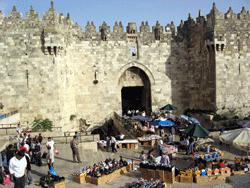 |
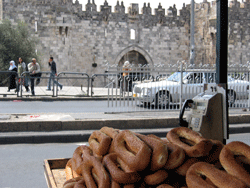 |
|
Photo: Gila
Yudkin |
Photo: Gila
Yudkin |
|
Market day at Damascus Gate |
Be sure to buy a "bagele" |
| |
As you
approach the gate, look down to your left, and
you’ll see the
2,000-year-old Roman Gate and tower,
possibly in place during the time of Jesus.
Note the flat-bellied “dressed” stone decorated with
indented margins, trademark of Herod the Great’s
skilled stone masons. This was part of a
triple-arched entrance to the second century AD
Jerusalem renamed Aelia Capitolina by the Roman
emperor Hadrian. The Roman Cardo (Latin for
Main Street) started here. You can stroll
along its later extension in the Jewish Quarter on
another day.
The Old Roman Gate was discovered by a British
archeologist named Hamilton in 1937 and excavated in
the 1980s by Israeli archeologist Menachem Magen.
When Jerusalem is once again flooded with tourists,
the gate will be reopened. In the meantime,
unfortunately, it is used as a garbage bin by the
vendors.
The Damascus Gate, called Sha’ar Shechem in
Hebrew and Bab el-Amud in Arabic, is the main
entrance to the Old City from the north. On
Fridays and Saturdays, when it’s elbow to elbow, if
you aren’t careful, your wallet may go home in
someone else’s pocket. It happens, even to the
natives, on market days!
About fifty yards inside the gate, you’ll come to a
fork in the road. The street on the right
leads (after a few twists and turns) to the Church
of the Holy Sepulcher. Take the left fork.
We pass through a covered market area and once we
come out to the sunlight again, we will take the
second left. You’ll see Armenian-decorated
wall tiles labeled Via Dolorosa, where we turn.
|
| |
We are now at the
Third Station of the Cross, where
Jesus fell for the first time. Before you
turn left, go forward just a few paces until
you are standing on huge
2,000-year-old
flagstones. They were found
two decades ago when modern pipes were being
laid eight feet beneath the street.
Archeologists dated the flagstones to the
first century AD from the coins and pottery
shards lying on them. It was then
decided to re-lay the stones at street
level, so today’s pilgrims could literally
walk in the footsteps of pilgrims of Jesus’
day.
Back up a few paces and turn left onto
the Via Dolorosa.
|
|
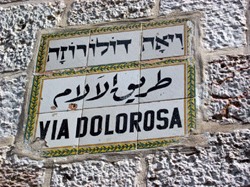 |
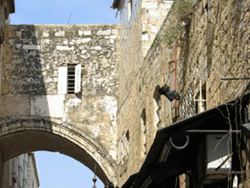 |
|
Photo: Gila
Yudkin |
Photo: Gila
Yudkin |
|
Look for this sign |
Ecce Homo Arch |
| |
Some of the shops on your right specialize
in icons, a number of which are imported
from the former Soviet Union. If you
are an “icon-noisseur,” you may find a rare
item to add to your collection. If you
are a novice, enjoy the Turkish coffee as
you browse the selection. Buyers
beware! The true bargain (in hundreds
of percent profit) is usually made by the
merchant.
Continuing on, the next point of interest is
the “traditional”
Ecce Homo Arch
over the street. It remembers Pontius
Pilate saying, “Here is the Man” to the
waiting multitudes. (John 19:5) (When
you face the Ecce Homo Arch, the
Temple Mount is
down the alley on your right, but the
entrance for non-Muslims is by the Dung
Gate) |
| |
Tour the Temple
Mount in the
company of Abraham and Isaac, David and Solomon,
Jesus and the disciples, the angel Gabriel and
Mohammed. Meet many other luminaries,
both real and legendary.
Gila's Temple Mount tour
is now available as a written
24-page PDF with a
Temple Mount plan,
guidelines for passing the security check
and ten recommended reads on the
Temple Mount from Gila's bookshelves.
|
Under the arch, on your left, is the
Sisters of Sion
church. (Sundays, the
church is closed to the public.)
Inside the church, for a small fee, take
advantage of the opportunity to examine a
segment of underground Jerusalem.
Descend to the cistern, originally a water
reservoir connected to the Antonia fortress,
built by Herod the Great.
Take a look at the “Lithostrotos”
(the Pavement) with its intriguing, carved
designs, believed to be “game-boards” for
popular games played by Roman guards on
duty.
Exiting the Sisters of Sion, turn left.
You’ll see a stone staircase with a grilled
railing leading up to a boys’ elementary
school called the Omariyyah. The
school is located on the site of the Antonia
Fort, named by Herod after his friend and
patron,
Mark
Antony. When Pontius Pilate came
to Jerusalem for the Passover Feast, it’s
believed that he stayed here. On Good
Friday, the Franciscans start their
procession along the Stations of the Cross
at the top of the staircase, inside the
school, with an exceptional view of the
entire Temple Mount. |
| |
On your left is the entrance to the
Church of the
Flagellation, Station One on the
Via Dolorosa. As you walk along the
Stations of the Cross, don’t look for
anything familiar from the “Passion of
Christ.” Mel Gibson didn’t film on
location!
As you exit, again turn left.
Opposite the public WC (water closet), is a
very friendly kiosk, the perfect place for
fresh orange juice or ice cream. Take
a moment to relax and people-watch along the
Via Dolorosa. (Please note – the
public WC is not the cleanest place in the
Middle East. Better to use the rest
rooms at the Sisters of Sion or the St. Anne
Church, coming up.)
|
Continuing straight down the hill, on your
left, before leaving the walled city, is the
Church of St. Anne
and the remnants of the
Pool of Bethesda.
The Crusader-built Church of St. Anne is
intact and is graced with an extraordinary
11-second echo. Take a seat towards the
front and sing your favorite hymn.
Don’t forget to pause at the end of each
verse, to appreciate the echo. “Halleluya”
and the Doxology are
pilgrim favorites.
Next to the church are the remains of the
original Pool of Bethesda where Jesus asked
the man who was lame for 38 years, “Do you
wish to be well?” (John 5) Over the
pool are ruins of churches built by the
Byzantines in the fifth century and the
Crusaders in the twelfth century.
When you’re ready to continue, we are
going to exit, turn left and leave the Old
City via St.
Stephen’s Gate. Tradition
has it that Stephen was martyred in the
Kidron Valley below us. Another popular name
for the gate is “Lions
Gate.” As you exit, turn
around and note two pairs of carved lions
over the entrance. Whoops – someone got that
wrong! If you look carefully, you’ll
see that the carved figures are not lions,
but leopards. However, the name “Lions
Gate” has stuck. |
| |
|
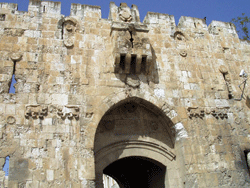 |
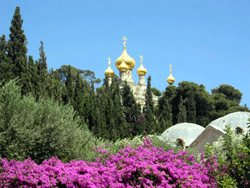 |
|
Photo: Gila
Yudkin |
Photo: Gila
Yudkin |
|
Lions Gate / St. Stephen's
Gate |
View of the Mary Magdalene
Church |
| |
We continue walking straight towards the
Kidron Valley. We cross the
street and continue down the hill.
A Greek Orthodox church dedicated to St.
Stephen is on our right and the Church of
the Assumption dedicated to Mary, further
along on our left. As we follow the
main road we see the Mount of Olives and the
gold onion domes of the Russian Orthodox
church dedicated to Mary Magdalene. The
road winds to the right and we reach the
Church of All
Nations, built by 16 Christian
nations at the close of World War I.
Over the triple arched portal is a
magnificent mosaic façade representing Jesus
as the hope of all humanity. After
admiring the façade and statues of the four
evangelists, we retrace our steps to
a narrow street leading up the Mount of
Olives. On our right is the entrance
to the Garden of
Gethsemane.
“Gethsemane” is derived from the Aramaic
word for “oil press.” It was here in
the Garden of Gethsemane that Jesus was
pressed so that he sweat blood. (Luke 22:44)
He spent a night of prayer here, instructing
his disciples to keep watch. It was
here that Jesus was arrested by the guards
of the high priest.
As you enter the garden, you’ll see the
eight oldest olive trees in Jerusalem,
estimated to be as much as 2.000 years old.
We can’t know the exact age of the trees,
for olive trees don’t grow in rings.
But we say, olive trees are like people, the
older they get, instead of getting taller,
they just get wider! Note how the
younger branches sprout right out of the
roots.
All other olive trees in Jerusalem and its
surroundings were apparently cut down by the
Romans as they were besieging the city.
These, however, survived, or at least their
roots did.
If you visit during the month of September
or October, you’ll see the trees heavily
laden with fruit, even at such an advanced
age. Proper pruning results in a bountiful
olive harvest.
Nearly 3,000 years ago, oil from the olive
tree was used to anoint the kings of Judah.
In Jewish tradition, the redeemer came to be
called the “Anointed One,” Meshiach in
Hebrew. Its English derivative is
“messiah.”
| |
|
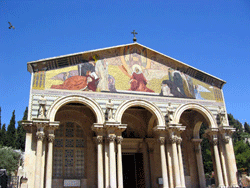 |
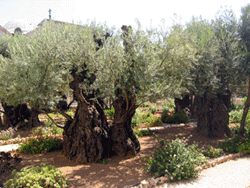 |
|
Photo: Gila
Yudkin |
Photo: Gila
Yudkin |
|
Church of All Nations |
2,000-year-old olive trees |
| |
|
Take advantage of two opportunities for
private time at the Garden of
Gethsemane. First, enter the Church of
All Nations. Perhaps you will
observe a pilgrim mass in progress, or
one of the regular Latin masses.
Then as you exit the garden, offer the
gatekeeper a little “baksheesh” (a
couple of shekels) to find the big black
iron key that opens the private garden.
It’s part of the authentic Garden of
Gethsemane, although its trees are
younger. You can usually find a
private spot for prayer. For many
pilgrims, private time at the
Garden of
Gethsemane is a highlight of their
spiritual journey. |
| |
|
Resources for the walk: |
| |
|
|
|
|
Coming to Jerusalem
soon?
Would you like to find the venues where you
can quietly be transported back in your
imagination to the time of Jesus? To
David? To Abraham? Make every
minute matter while you "Explore
Jerusalem's Soul" with Gila's
ultimate guide.
This up-to-date PDF (Adobe Acrobat)
46-page guide gives you the Top Ten places
to
meditate on the Bible, the Top Ten lesser-known
churches worth visiting, the Top Ten most
rewarding roof-top views and the Top Ten places
for sampling Middle Eastern soul food. Pick and choose
among 40 sites according to your temperament, time
frame, impulse and imagination. More on
Gila's Jerusalem Guide... |
|
|
|
GILA
YUDKIN
•
TCHERNIKOVSKI
64A
•
JERUSALEM
•
ISRAEL
gila@itsgila.com
HOME
•
HOLY
LAND
HEROINES
•
HOLY LAND HEADLINERS •
ABOUT GILA
|
|

